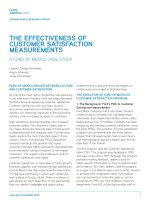Authority leadership marketing making content the cornerstone of customer engagement and relevance
Bạn đang xem bản rút gọn của tài liệu. Xem và tải ngay bản đầy đủ của tài liệu tại đây (2.53 MB, 7 trang )
A GlobalFluency White Paper and Opinion Editorial
GlobalFluency powers global
affi nity networks including
Making Content
the Cornerstone of
Customer Engagement
and Relevance
AUTHORITY
LEADERSHIP
MARKETING
03
PAGE
the key
to engagement
04
PAGE
relevance
drives consumption
05
PAGE
advancing
content roi
06
PAGE
about globalfluency
TABLE
of
CONTENTS
Marketers increasingly recognize they must become
thought leaders, knowledge brokers, and insightful
publishers to build rapport with target audiences.
In today's mult-channel, search-oriented media landscape,
corporate buyers, specifiers, and influencers tend to tune
out traditional marketing and communications.
The real challenge for markerters is to define strategic
agendas and advocacy platforms that condition
and predispose decision makers, as well as harvest
opportunities and prospects for sales.
GlobalFluency’s special competency is Intelligent Market
Engagement™, an integrated approach that leverages
best-in-class content marketing and thought leadership
practices to accent market needs, predispose decision
makers, and rapidly accelerate lead generation.
AUTHORITY LEADERSHIP MARKETING
|
WHITE PAPER
Why did Symantec fund a study on the
impact of customer data breaches on brand
trust and reputation? What made SGI and
Intel embrace an IT sustainability agenda
called Think Eco-Logical? Why does Adaptive
Planning conduct a quarterly Business
Volatility and Variables Audit targeting mid-
market CFOs?
These are just a few examples of successful
authority leadership marketing initiatives
at work as B2B companies seek to connect
and engage with their markets using more
relevant, customer-centric content delivered
in new digital formats and channels.
Marketers increasingly recognize that they
must become thought leaders, knowledge
brokers, and insightful publishers to build
rapport with target audiences and create
strategic conversations with decision makers
and influencers. This means paying more
attention to content marketing performance,
impact, and return on investment, particularly
as it relates to lead acquisition, customer
predisposition, trust building, and shortening
of selling cycles.
Bringing more rigor, creativity, and strategic
thinking to content specification, origination,
packaging, and delivery is now a strategic
imperative for marketers as they seek to drive
content consumption and knowledge sharing.
Sales and channel organizations recognize the
need to prime their pipelines and upsell and
cross-sell customers with credible, strategic
content. Companies, both global and
emerging, realize the need to use content to
drive brand relevance and authority. Content
investments by B2B technology companies
now account for as much as 25 percent of
marketing budgets (CMO Council). And this
percentage will continue to grow, fueled
by multiplying formats, delivery channels,
platforms, audiences, device types, and
consumption rates worldwide.
Content marketing within the B2B sector
is being driven by an upsurge in executive
participation in the strategic procurement
process, as well as the ready availability of
meaningful decision support content, affinity
groups, and professional peer networks
on the Internet. There is an increasing
opportunity for direct market engagement—
for reaching, aggregating, and segmenting
customer audiences while bypassing
traditional media and analyst avenues. To do
so, marketers are developing and outsourcing
some of the same skill sets and resources
of those more traditional media and analyst
groups. They are forming their own shared
interest communities and channels of insight,
access, and influence.
Today’s “digital content factories” have to
run at full capacity to keep pace with rapid
changes in market conditions, customer
sentiments, competitive threats, and
technology advancements. Marketers have to
become adept at listening and responding to
the “voice of the customer,” which requires a
new form of intelligent market engagement
and continuous interaction around customer
issues, problems, pain points, risks,
vulnerabilities, deficiencies, and challenges.
With more and more digital content
publishing, syndication, conversation, and
distribution channels proliferating—such as
websites, customer communities, social media
channels, online business networks, Internet
forums, discussion groups, blogs, podcasts,
on-demand webcasts, video portals, mobile
devices, email, SMS text messaging, IPTV, web
conferencing systems, and live virtual event
environments—content has to be configured
and produced in a multiplicity of formats and
delivery modes to optimize consumption,
recall, sharing, influence, and action.
To be successful in this new ethos, marketers
must put into place clear content development
strategies and effectiveness auditing
protocols. Rather than delivering self-serving
messages, they must speak to relevant themes
and topic areas, author higher-quality content
that is more visual and engaging, as well as
build efficient content syndication networks
that maximize audience reach and activation.
They must put into place performance
measurement and tracking systems to assess
the performance, impact, and payback of their
content marketing programs.
"Bringing more rigor,
creativity, and strategic
thinking to content
origination and delivery
is now a strategic
imperative."
THE KEY
TO ENGAGEMENT
Content investments by B2B
technology companies now
account for 25 percent of
marketing budgets.
CMO Council
Interesting content is one of
the top three reasons people
follow brands on social media.
Content+
3
AUTHORITY LEADERSHIP MARKETING
|
WHITE PAPER
COPYRIGHT GLOBALFLUENCY
ALL RIGHTS RESERVED
2012
©
RELEVANCE
DRIVES CONSUMPTION
Relevance is the essential attribute B2B
marketers must deliver in order to be
successful in content marketing. Content
cannot just be about your company and
your product; it has to be about your
audience. Content being generated by
winning companies today goes well beyond
traditional trumpeting of product features and
functions, speeds and feeds, and deals and
deployments. In today’s multi-channel, search-
oriented media landscape, corporate buyers,
specifiers, and influencers tend to tune out
traditional marketing communications. They
spend more time conducting independent
research on the web and obtaining
information and advice from peers and other
trusted third-party sources.
Numerous studies have demonstrated that
peers are the most trusted and influential
sources of advice and information among B2B
decision makers. B2B buyers depend on peer
advice more than any other source in forming
purchase decisions. Thus, affinity networks
of professionals who share similar challenges
and needs are a rich resource for content
creation and insights.
Central to an effective content marketing
program is the definition of a strategic
advocacy agenda and point of view. This
comes out of exhaustive online and offline
discovery as well as invention sessions and
continuous engagement with partners,
customers, and the channel. Online surveying
and perception polling, as well as social
and live interactions, can add credibility
and substance to this form of advocacy and
thought leadership.
For example, with the Think Eco-Logical
advocacy program, SGI and Intel were able
to engage CIOs and other IT executives in
an in-depth conversation about the cost
savings and environmental improvements
obtainable through server consolidation
and more power-efficient platforms. An
executive survey and study report advocating
energy-saving practices generated more than
1,000 downloads while driving significant
online discussion and media coverage. The
Think Eco-Logical program created further
advocacy and interaction with its target
audience through the creation of a graphical
appealing, “video game-like” eco-IT monitor
that executives used to calculate the impact
of data center changes on energy costs and
carbon emissions. This not only delivered a
value-added service, but also generated rich
customer profiling information and contact
data for further nurturing and cultivation.
Peer networks of executives provide built-
in communities for content marketing
engagement. Professionals with shared
challenges and issues can spark highly relevant
insights and discussions for others inside and
outside of the network. When Oracle’s on-
demand CRM business unit teamed with the
CMO Council to launch a campaign to improve
integration and alignment of traditionally
divided sales and marketing functions, the
result was the creation of The Coalition to
Leverage and Optimize Sales Effectiveness
(CLOSE—www.closebiz.org).
High-level brainstorm sessions on sales and
marketing integration engaged targeted
audiences in Paris, London, Sydney, Sao
Paulo, New York, and Silicon Valley, each
creating a best-practice report that was
syndicated worldwide and generating
some 15,000 leads. During a six-month
period, this affinity network aggregated and
touched more than 27,000 executives and
professionals worldwide through outreach,
events, surveys, and global media relations.
The dedicated www.closebiz.org website
continues to aggregate content, commentary,
and community, providing a rich and
robust channel of market engagement for
sponsoring brands.
To underscore and highlight the need for
improved business intelligence systems and
better decision economics, Cognos teamed
with the Business Performance Management
(BPM) Forum—now the Business Performance
Innovation (BPI) Network. This C-level peer
network brought together executives concerned
with the speed and quality of decision making
within their enterprises. DecisionROI put the
"Peer networks of
executives provide
built-in communities
for content marketing
engagement."
LinkedIn generates more
leads for B2B companies
than Facebook, Twitter, or
blogs individually. Yet only
47 percent of B2B marketers
say they use LinkedIn versus
90 percent on Facebook.
Inside View
Social media sites and blogs
reach 8 out of 10 of all U.S.
Internet users and account
for 23 percent of all time
spent online.
Content Marketing Institute
Sixty percent of marketers
plan to increase their
spending on content
marketing over the next
12 months.
Content Marketing Institute
4
AUTHORITY LEADERSHIP MARKETING
|
WHITE PAPER
COPYRIGHT GLOBALFLUENCY
ALL RIGHTS RESERVED
2012
©
issue of decision economics into play and
aggregated a large executive audience through
the creation of a dedicated campaign site,
social and traditional media engagement, and
publication of a variety of reports and online
advocacy content, including insights from
interviews with top executives and an online
survey of hundreds more.
Symantec took another innovative approach
to generating customer demand by making
data security a strategic business issue that
embraced a broad set of business decision
makers across the marketing, finance, investor
relations, operations, and supply chain sectors.
It implemented a content marketing campaign
called “Secure the Trust of Your Brand,” which
included executive and consumer surveys in
North America and Europe, as well as a study
by Emory University of 15 leading brands
that had been compromised by customer
data breaches. This analysis included a look
at the loss of shareholder value, tonality and
sentiment of media coverage relating to
reputation, and the business continuity impact
relative to both suppliers and customers.
Survey data revealed a significant percentage
of consumers were concerned about digital
security and would not continue to do business
with a company that exposed their personal
information to hackers and cyber bandits. Not
only did the study attract worldwide attention,
but authors of the report were invited to
present findings at the seminal Visa Security
Summit in Washington, D.C., which was
attended by leading government agencies,
bankers, retailers, and other key customer
targets for Symantec.
ADVANCING
CONTENT ROI
Most companies in complex, multi-channel
markets such as information technology,
business solutions, communications,
connectivity, security, audio/video,
professional services, and industrial systems
need to assume thought leadership positions
and provide meaningful insights, perspectives,
and commentary on market needs, problems,
issues, trends, and requirements. In most
cases, the knowledge capital and authority
leadership come from effective market
engagement, real-time customer feedback and
listening, primary research, media analytics,
as well as regular monitoring and mining
of conversations and discussions in online
communities, affinity groups, forums, blogs,
newsgroups, and bulletin boards.
The real challenge for marketers is to define
strategic agendas and develop advocacy
platforms that condition and predispose
decision makers, enable conversations and
introductions, gain prominence and visibility, as
well as harvest opportunities and prospects for
sales, business development, and partnering.
Too few companies have formal content
development strategies, relevant content creation
themes and topic areas, efficient content
origination capabilities, effective content delivery
networks or channels, or measurable content
performance and tracking systems.
Random acts of content development occur
across the organization without unifying and
consistent themes, messages, brand value,
or visual identity reinforcement. The CMO
Council’s new Content ROI Center is aimed
at raising the caliber of content produced
in organizations, as well as the impact and
influence this content might have on brand
awareness, perception, deal contention, and
buyer/specifier consideration. It will also look
at the role and value of marketing content
in the process of sales lead acquisition,
qualification, conversion, and closure, as
well as its contribution to ongoing customer
retention and revenue generation.
By Dave Murray
Executive Vice President of GlobalFluency, Inc.
An innovator and architect of authority
leadership marketing, Murray leads the
content marketing practice of GlobalFluency,
which is based in Silicon Valley. His firm
operates a number of international executive
affinity networks, including the Chief
Marketing Officer (CMO) Council and the
Business Performance Innovation (BPI)
Network.
Contact Information
dmurray@globalfluency.com
Direct Phone: 650-433-4141
Sixty-two percent of
companies outsource their
content marketing, up 7
percent from last year.
Mashable
Forty percent of U.S. tablet
owners read newspapers and
magazines on their devices.
comScore
Google’s Android holds
a 68 percent share of the
smart phone market versus
17 percent by Apple as of
the second quarter of 2012.
IDC
5
AUTHORITY LEADERSHIP MARKETING
|
WHITE PAPER
COPYRIGHT GLOBALFLUENCY
ALL RIGHTS RESERVED
2012
©
AUTHORITY LEADERSHIP MARKETING
|
WHITE PAPER
GlobalFluency is a high-performance marketing and communications services firm offering clients breakthrough
programs for influencing markets, growing customer relationships, and building valued brands. Its capabilities
span brand activation, content marketing, creative and digital services, public relations, social engagement,
lead generation, and executive affinity network management.
GlobalFluency’s special competency is Intelligent Market Engagement™, an integrated approach that leverages
best-in-class content marketing and thought leadership practices to accent market needs, predispose decision
makers, and rapidly accelerate lead generation and prospect harvesting.
Headquartered in Palo Alto, Calif., GlobalFluency has aggregated important executive audiences into vibrant
channels of insight, access, and influence, including the Chief Marketing Officer Council, the Business
Performance Innovation Network, the Global Renewable Energy and Environmental Network (GREEN), and
others. It has also developed the creative and practical competencies required to design, integrate, execute,
and measure campaigns worldwide. www.globalfluency.com
The Digital Marketing Performance
Institute is a dedicated research
center of the CMO Council focused
on measuring and tracking the
effectiveness, relevance, and value of
online marketing practices, programs,
and spending. It advocates the need
for unified and integrated approaches
to managing and optimizing today’s
fragmented interactive marketing
discipline, especially across leading
vertical markets. Authority leadership
and content aggregation by the Digital
Marketing Performance Institute will
drive best practice adoption; audit and
assess competencies and proficiencies;
establish measurement models
and techniques; evaluate enabling
platforms, solutions, and technologies;
and help marketers increase visibility,
compliance, accountability, and ROI.
Areas of special focus include CMO
strategy, talent sourcing, social media,
search marketing, online advertising,
campaign localization, mobile
marketing, marketing automation
platforms, eCommerce, and online
brand protection.
www.onlineperformance.org
The Chief Marketing Officer (CMO)
Council is dedicated to high-level
knowledge exchange, thought
leadership, and personal relationship
building among senior corporate
marketing leaders and brand decision-
makers across a wide range of global
industries. The CMO Council's 6,000
members control more than $300
billion in aggregated annual marketing
expenditures and run complex,
distributed marketing and sales
operations worldwide. In total, the
CMO Council and its strategic interest
communities include more than 20,000
global executives in more than 110
countries covering multiple industries,
segments, and markets. Regional
chapters and advisory boards are active
in the Americas, Europe, Asia-Pacific,
India, Middle East, and Africa. The
CMO Council's strategic interest groups
include the Coalition to Leverage and
Optimize Sales Effectiveness (CLOSE),
LoyaltyLeaders.org, Marketing Supply
Chain Institute, Customer Experience
Board, Market Sense-Ability Center,
Digital Marketing Performance Institute,
GeoBranding Center, the Forum to
Advance the Mobile Experience (FAME),
and the cause-directed research
initiative, Pause to Support a Cause.
More information on the CMO Council
is available at www.cmocouncil.org.
The Business Performance Innovation
(BPI) Network is a global community
of executives dedicated to identifying,
exploring, and sharing emerging trends,
transformational ideas, and inventive
practices and business models. The
BPI Network aims to help senior-level
executives and their organizations
become more adaptive, agile, and
relevant in a digitally driven, resource-
constrained, and highly complex and
competitive global marketplace. The
BPI Network researches, develops,
and promotes peer-powered thought
leadership content and conversations.
Its membership includes senior
executives across multiple industries
and disciplines who are responsible
for how their companies identify
strategic opportunity, serve and
develop customer markets, measure
and improve operational effectiveness,
manage growth and risk, and
source, develop, and motivate talent
worldwide. www.bpinetwork.org
About GlobalFluency
GlobalFluency powers
6
AUTHORITY LEADERSHIP MARKETING
|
WHITE PAPER
COPYRIGHT GLOBALFLUENCY
ALL RIGHTS RESERVED
2012
©
BRAND CONTENT IS NOT
UNLIKE TAKING FRESH
PRODUCE TO MARKET
• Invest in careful cultivation
• Keep it fresh and appealing
• Pick and ship at the right time
• Assure proper display and handling
• Watch shelf life and spoilage
• Pack for all channels of distribution
Find out more about “Keeping a Closer Eye on Content ROI” with the
Chief Marketing Offi cer (CMO) Council and the Custom Publishing
Council. Visit : www.cmocouncil.org/r/content-roi-whitepaper
Copyright © CMO Council. All rights reserved.









